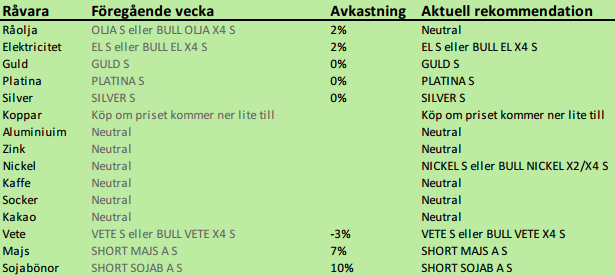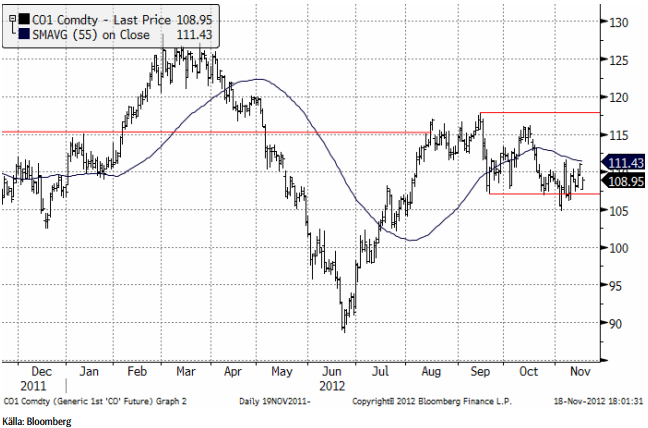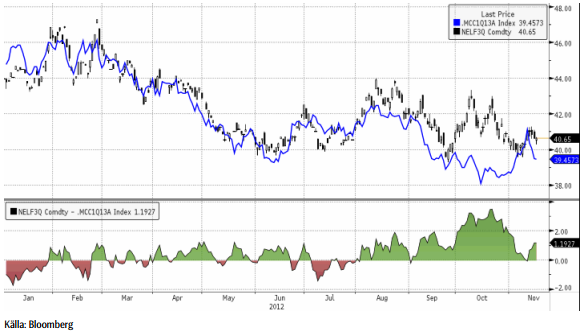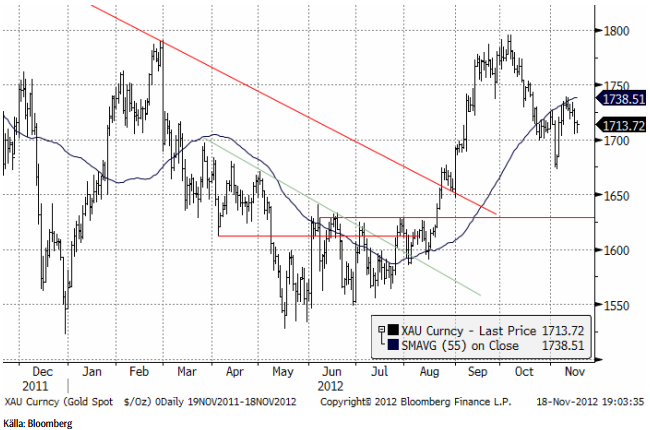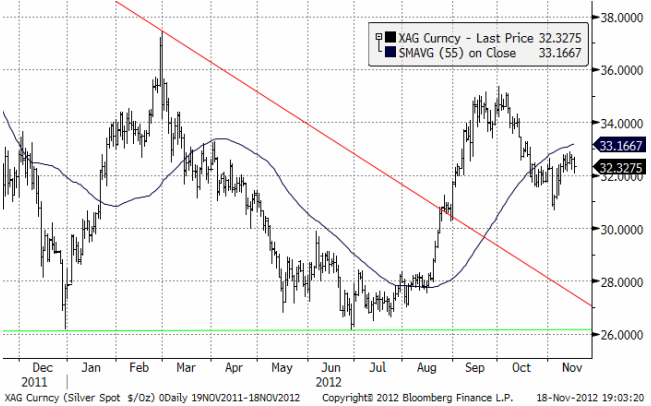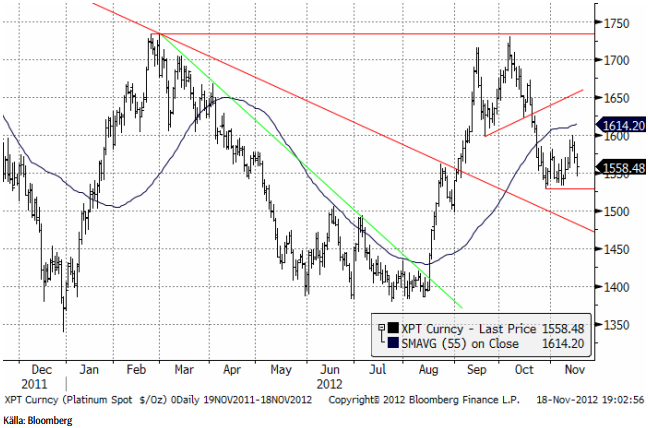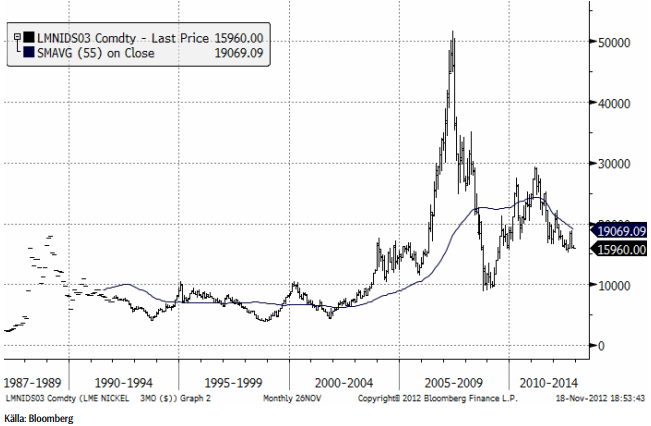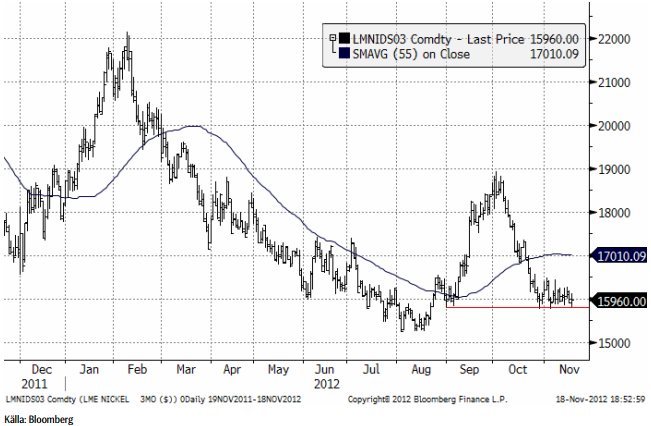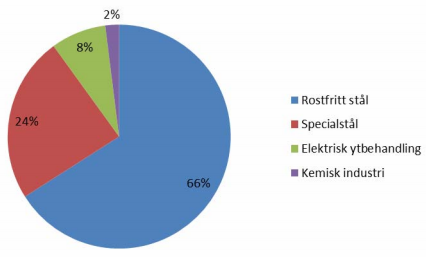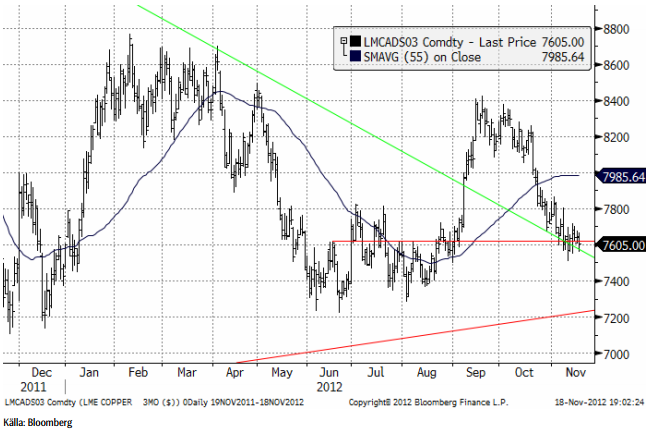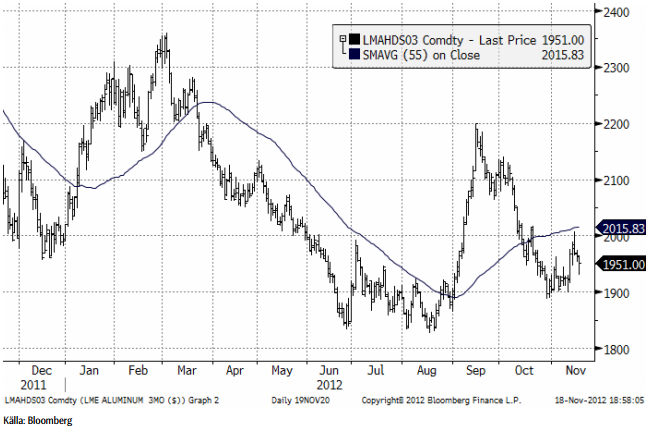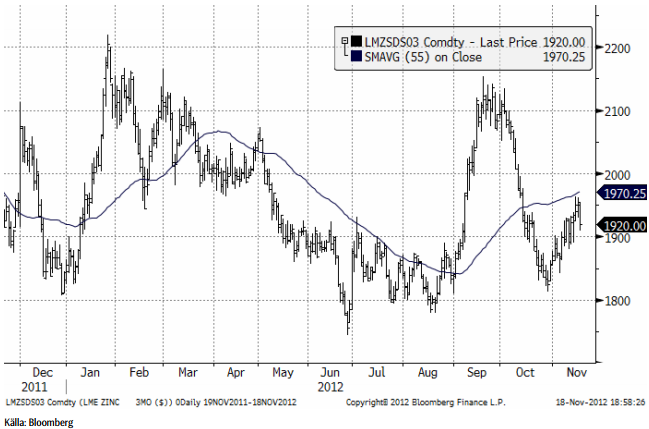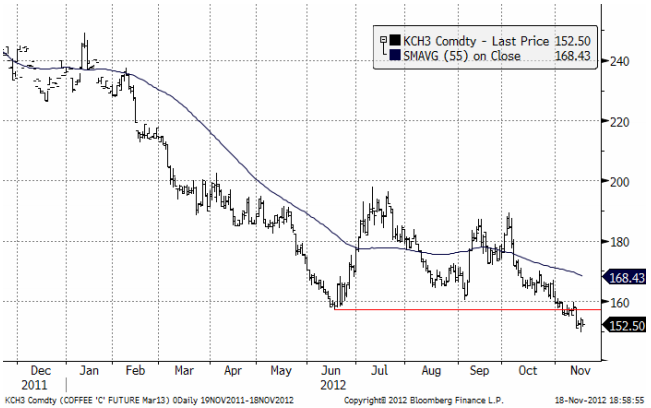Analys
SEB – Råvarukommentarer, 19 november 2012
Rekommendationer
Vi inleder bevakningen av Nickel med en köprekommendation. Majs och sojabönor föll förra veckan, vilket fick våra positioner i SHORT-certifikat att utveckla sig väl. Guld, silver och platina tyngs av en stark dollar. Vi tror att dollarn kan fortsätta att stärkas. Detta innebär att noteringarna i dollar kan bli lägre, men då inte nödvändigtvis i svenska kronor. Vi går över till neutral rekommendation på olja, efter förra veckans prisuppgång. Vi är alltjämt positiva till elpriset och rekommenderar köp av t ex EL S.
Råolja – Brent
Veckan som varit har präglats av oro för – och nedjusteringar av efterfrågan, vilket tyngt priset. Samtidigt har det varit förnyad geopolitisk oro, där Israels försvar mot Hamas raketbeskjutningar är det senaste tillskottet. Situationen i och kring Syrien med potentiella spridningsrisker till grannländer som Turkiet och inte minst Israel, utgör ytterligare hot. Balansen mellan utbud och efterfrågan är mindre ansträngd efter de senaste nedjusteringarna av efterfrågan samt starka produktionssiffror från länder som Irak och Libyen. I nuvarande miljö minskar det risken för oljepriser över 120 USD/fat. Samtidigt utgör situationen i Mellanöstern med ovan nämnda oroshärdar samt den nyuppblossade konflikten mellan Israel och Hamas och de pågående sanktionerna mot Iran, en risk. Blir det en större eskalering av någon av konflikterna kan priset på olja snabbt rusa.
International Energy Agency, IEA, justerade i veckan ned efterfrågeprognosen för Q412 något till 90,1 miljoner fat per dag (-0,3 miljoner fat). Skälet är den svaga utvecklingen i Europa samt det tillfälliga bortfallet i efterfrågan som följde på stormen Sandy. Produktionen justerades samtidigt upp, även det måttligt men sammantaget är balansen i marknaden nu bättre. IEA justerar också ned tillväxtprognosen för 2013 och räknar nu med en ökning på +0,83 miljoner fat jämfört med år, vilket är mindre än tidigare.
IEA kommunicerade också dramatiska förändringar i den globala energibalansen. Organisationen räknar med att USA, p g a ny teknologi som shale-oil/gas tekniken, kommer passera Saudi Arabien som världens största oljeproducent år 2017 och Ryssland som den största naturgasproducenten redan år 2015. Det är en radikal förändring med det tidigare budskapet där Saudi beräknades vara största oljeproducent ända till 2035. Onekligen ritas världens energilandskap om och balanserna ändras. IEA räknar därmed med att USA blir nettoexportör år 2030. Idag står import för ca 20% av USA:s energibehov. Det kommer också att innebära att olja från Mellanöstern, i högre grad än idag, kommer avsättas i den starkt växande asiatiska marknaden. Så servi att de allt för verklighetsanpassade förespråkarna inom ”peak oil” rörelsen, fått ordentligt fel, därför att de inte tar hänsyn till att produktion är beroende av pris och teknisk utveckling.
Veckans DOE rapport visade att de amerikanska råoljelagren minskade med 1,1 mfat mot förväntat upp 2,6. Distillates föll med hela 2,6 mfat mot väntat ner 0,9.
I veckan har Brentkontraktet stigit. Våra certifikat följer nu januarikontraktet och vi har fått del i ytterligare en gynnsam backwardation rullning. Trots bättre utbuds-/efterfrågebalans och trots en oroväckande teknisk formation, se graf, där en stängning under 104.76 öppnar för ytterligare fall, så tycker vi att den nedre delen av handelsintervallet, kring 105-106 nivån, är köpvärd, då;
- Vi det bedömer det som osannolikt att priset på råolja, varaktigt, kommer att falla under 105-nivån, såvida inte tillväxtprognoserna skrivs ned väsentligt. Den senaste statistiken från både Kina och USA indikerar att det värsta kanske ligger bakom oss. Samtidigt är situationen i Europa fortfarande illavarslande.
- Oljepriset kommer att fortsätta vara väl understött av stora geopolitiska risker. Ökad spänning i veckan som varit, har redan lyft priset.
- Det krävs ett högt oljepris för att stimulera tillräckliga investeringar i ny kapacitet.
- Många producentländer behöver ett högt pris för att balansera budgeten.
- Brent lämpar sig väl för produktion av mellandestillat som bensin och diesel. Lagren av mellandestillat är historiskt låga och den kommande vintern riskerar att urholka lagren ytterligare.
- Produktionen i Nordsjön har, under hösten, varit kraftigt begränsad. Problemen skulle nu ha varit lösta men istället meddelades nyligen ytterligare störningar och förseningar.
I fredags stängde kontraktet på 109 usd, där vi håller en neutral rekommendation.
Nedan ser vi spotkontraktets kursutveckling. Priset ligger strax under 110 dollar och det ser ut som om man kan förvänta sig ”sidledes” rörelse i veckan som kommer.
Elektricitet
Vädret är fortfarande milt med mycket nederbörd och den hydrologiska balansen är stark efter ett år med mycket regn. Kärnkraften producerar 95% av fullt. Inför vintern ser läget därför mindre ansträngt ut än tidigare vintrar.
I förra veckans brev argumenterade vi för att det finns god potential för högre elterminer, enligt nedanstående resonemang;
Kostnaden mellan att producera el i kolkraftverk vilket oftast är marginalprissättande och elterminerna, har under en tid varitovanligt stor, se graf nedan. Därmed har det, tidigare, funnits mer fallhöjd i elterminerna. Sedan mitten av oktober har differensen successivt minskat, då;
- Elpriset fallit
- Det europeiska priset på kol och utsläppsrätter har stigit.
I grafen är marginalkostnaden för kolkraft, blå linje, justerad. Verklig marginalkostnad är lägre.
Den utlösande faktorn för högre elpriser kommer sannolikt vara ett väderskifte. Sommaren och hösten har varit nederbördsrik. Blötvädret är redan inprisat, varför ett skifte till kallare och torrare väder bäddar för snabb uppgång. De båda uppgångar som skedde i oktober följde båda på moderata väderleksskiften, vilket visar på potentialen. Vår rekommendation är att ligga steget före, alltså att köpa innan ett eventuellt väderskifte, då det med stor sannolik kommer vara försent att agera när skiftet väl bekräftas.
I veckan som varit, har också terminerna handlats upp något, i linje med vårt resonemang ovan men utan att vi egentligen mer än anade en tendens till väderskifte, prognoserna är fortsatt milda med nederbörd något över normal. Samtidigt så har marginalkostnaden fallit som en följd av lägre pris på utsläppsrätter, vilket därför tillfälligt begränsar potentialen i en uppgång något.
Eftersom ”utfallsrummet” är begränsat (vi tror inte på priser över 44), rekommenderar vi certifikatet BULL EL X2 S, för att erhålla god utväxling på prisrörelsen. Nedsidesrisken har ökat något sedan förra brevet, varför vi påminner om vikten av en exit-strategi.
SEB har följande börshandlade certifikat kopplade till elterminer på Nasdaq OMX.
Long ———– Short
EL S Bear —– El X2 S
Bull El X2 S — Bear El X4 S
Bull El X4 S
Guld och Silver
Guldpriset föll på den nya utbuds- och efterfrågerapporten från World Gold Council i veckan. Priset brukar stiga på rapporter från dem, eftersom de är en intresseorganisation för branschen, framförallt för producenterna. Att det inte blev så den här gången beror på att siffrorna visade på minskad efterfrågan från Kina. Däremot ökade efterfrågan det tredje kvartalet från Indien. Oktober är den stora vigsel-månaden i Indien. Bara i New Delhi kan det vara 25,000 bröllop på en dag. Den traditionella gåvan till bruden är guldsmycken, eftersom detta är en ägodel som förblir hennes för alltid.
Nedan ser vi kursdiagrammet för silver i dollar per troy ounce. Situationen är identisk med den för guld.
Tekniskt, ser kursutvecklingen svag ut. Priset för både guld och silver kan mycket väl falla av.
Platina
Platinapriset stötte på motstånd på 1600 dollar per troy uns och föll sedan ner till 1558 i fredags. Stöd finns på 1528. Om priset faller under den nivån bör man gå ur alla positioner.
Basmetaller
Koppar och nickel stänger veckan marginellt ned medan zink och aluminium är upp 0,8 % respektive 1,5 %. Marknaderna står och väger. Förväntad återhämtning av tillväxten i Kina motverkas av oro för amerikanska budgetförhandlingar och svagare industrikonjunktur i Europa. Den uppblossade konflikten på Gazaremsan har förstärkt oron för ett fullskaligt krig i regionen.
Kinas State Reserve Bureau (SRB) verkställde en första runda av de annonserade strategiska köpen av 100 tton aluminium och lika mycket zink under torsdagen. Enligt lokala källor ska 400 tton aluminium köpas in vid fyra tillfällen. Köpen är en kvarvarande del av det mandat som SRB fick i samband med krisen hösten 2008. Enligt uppgift finns utrymme att köpa mer av nämnda metaller, men även koppar.
Den stora frågan i metallmarknaden de kommande veckorna/månaderna, är vad den nya ledningen i Kina kommer presentera i form av eventuella stimulanser. Huvudspåret är att de kommer att koncentrera sig på inhemsk konsumtion, vilket troligtvis innebär att de traditionella infrastrukturinvesteringarna inte blir lika omfattande som tidigare. Det scenariot är nog ganska ”inprisat” i marknaden, vilket bidragit till den svagare pristrenden under hösten. Blir det mer än väntat påverkas metallerna.
Vi ser ett mer positivt scenario (mer sannolikt), och ett lite tråkigare (mindre sannolikt).
Positivt scenario: Kina stimulerar vidare med sina infrastrukturprojekt mer än marknaden förväntat (de blir ”tvungna” för att uppfylla tillväxtmålen). Europa, USA och Japan fortsätter med de penningpolitiska stimulanserna. Investeringskapital flödar in i råvaror som inflationsskydd. USA får till en lösning av ”budgetstupet” (det mest troliga). Industrin ”vaknar till liv” och börjar bygga lager.
I det mindre positiva scenariot ”vilar Kina på hanen” och låter tidigare gjorda investeringar få ”verka ut” och att de med viss försiktighet blir mer återhållsamma på investeringsfronten, och fokuserar mer långsiktigt på ökad konsumtion. De monetära stimulanspaketen (USA, Europa och Japan) får inte avsedd effekt bl.a. p.g.a. alltför svag arbetsmarknad i USA. I det scenariot uteblir prisuppgångarna på metallerna, men det behöver inte innebära någon större prisnedgång! Risken är större på uppsidan.
Nickel – veckans metallspecial
Prisrörligheten på nickel är vanligtvis större än på övriga basmetaller. Under det stora basmetallrallyt 2004-2008 nådde prisetnivåer upp mot $50000/ton, för att under krisen 2008 falla ned till $10 000. Under senare år har priset etablerat sig i intervallet $ 15–25 000. Nickel är en dyr legering och den mest avgörande för priset på rostfritt stål. Ett vanligt rostfritt stål kallas för 18/8-stål. Vi använder det i diskbänkar och bestick, t ex. Det består av 74% vanligt stål, 18% krom och 8% nickel. Den dyraste ingrediensen är nickel.
66 % av nickelproduktionen går till produktion av rostfritt stål. Hela 90 % går till någon form av stålframställning. Historiskt har nickel ofta hamnat i bristsituationer, delvis för att produktionen suttit på relativt få händer, där ryska Norilsk är en betydande producent och står för ca 20 % utbudet. Produktionsstörningar har hört till vanligheterna. På senare år har utbudet blivit mer spritt och fått ”konkurrens” från, dels produktion av s.k. Nickel Pig Iron, tackjärn som produceras i Kina med högt nickelinnehåll (baserat på malm från Indonesien och Filippinerna) samt av nya produktionstekniker (High Pressure Acid Leaching), med s.k. urlakningsmetoder. Den har länge varit på forskningsnivå och har först på senare år på allvar börjat utmana traditionell nickelframställning. Osäkerheten kring tekniken och dess potentiella bidrag till utbudet har i sig skapat stor prisvolatilitet för nickel.
I nuläget är vi i en situation där efterfrågan framför allt är vikande i Europa med överkapacitet i den rostfria stålindustrin. USA däremot ökar, samtidigt som Kina fortsätter en hög produktionstakt för att uppnå uppsatta produktionsmål. Den globala rostfria stålproduktionen förväntas öka med 3,5 % i år. Givet att HPAL-produktionen kommer till stånd som planerat (något som tidigare år sällan inträffat) pekar det på en nickelmarknad i balans till ett visst överskott om ca 25-50 tton (i förhållande till en global produktion på ca 1,6 Mton). Vad marknadens aktörer vet av erfarenhet är att det svänger väldigt snabbt. Den rostfria industrin är väldigt ryckig. Ur ett produktionskostnadsperspektiv anses allmänt $15000 utgöra ”nickelbotten”, d.v.s. när produktionen blir tillräckligt olönsam för att initiera produktionsneddragningar. Vi är således nära vid dagens $16000. Den rostfria stålproduktionen har ökat i genomsnitt med 5 % de senaste 20-25 åren, då rostfritt är ett ”vinnande” material. Således när efterfrågan närmar sig trend så är potentialen för ökad tillväxt från dagens nivå ganska stor. I det mer positiva scenariot (se under ingressen till basmetaller) bedömer vi potentialen på uppsidan som stor, på 12 månaders sikt kan vi ganska lätt få se $20 000. Nivåer upp $25000, d.v.s. en uppgång på 50 % från dagens nivåer, är inte alls en omöjlighet på lite längre sikt. Man får heller inte glömma att för fem år sedan kostade 50000 dollar.
Nickelpriset på LME perioden 1987-2012
Nickel är generellt en köpvärd metall På kort sikt pendlar nickel mellan $15 800- $16 200. Vi avvaktar för att se hur den kommer att ”bete sig” kring stödnivåerna. Ett genombrott av motståndsnivån $16500 skulle signalera en kortsiktig köpsignal.
Nickels användningsområden
Vi rekommenderar köp av NICKEL S eller BULL NICKEL X2 / X4 S för den som vill ta mer risk. Man bör gå ur positionen om priset faller genom 15,800 dollar per ton, som är stödet i den konsolideringsfas som varit rådande sedan prisfallet slutade i slutet av oktober.
Koppar
LME-koppar avslutade veckan på minus 0,2 % på $ 7620. Vi har varnat för risken för prisfall ned mot den lite mer avgörande tekniska nivån $7400, vid ett definitivt brott av $7600. Det står och väger. Koppar är den ledande basmetallen och sätter ofta tonen för hela komplexet. Det är också den mest Kinakänsliga metallen. Resonemanget ovan för basmetaller i stort gäller i allra högsta grad för koppar. Makroscenen de närmsta veckorna, och i synnerhet vad som kommer från kina, blir avgörande. Resonemanget kring marginalkostnader gäller inte koppar på samma sätt som för övriga basmetaller, vilket gör att prisfallsrisken möjligtvis är lite större. Vad som motiverar ett relativt högre pris är ”riskpremien” för Kinas stora importbehov, i kombination med ett eftersläpande utbud, främst beroende på låga halter och försenade projekt. Vi är fortsatt lite avvaktande (främst p.g.a. den tekniska bilden), men är beredda och letar köplägen.
Aluminium
Aluminium har varit i blickfånget under veckan. Priset stänger veckan upp 1,5 % på $1950 efter att ha varit uppe och nuddat vid $2000. Rykten i början av veckan om Kinas strategiska köp av 400 tton, fick priset att stiga kraftigt. Torsdagens bekräftade köp av 100 tton (som enligt uppgift kommer att följas av tre poster till), fick aktörerna att ta hem vinster med påföljande rekyl. Den tekniska bilden ser mer positiv ut för aluminium och långsikta tekniska analyser tyder på en ”urbottningsfas”. Om priset kommer ned till $1900 igen är det köpläge. Potentialen är ganska stor. Priset var så sent som i september uppe i $2200 (12 % högre).
Zink
Zink och aluminium är på ett sätt i en liknande situation. Lagernivåerna är höga, men till stor del uppknutna i s.k. contangoaffärer. Det innebär att hedgefonder och handelshus köpt metall i LME-lager och samtidigt sålt på termin när contangon (terminspremien) är tillräckligt hög för att göra vinst (Contango-finansieringsränta –lagerhyra > noll). Detta i kombination med kapacitetsproblem i lagerhusen för utlastning, undanhåller en betydande del av materialet från den fysiska marknaden. Veckan stängde upp 0,8 % på $1905. Kina köper zink strategiskt, och bekräftade även här ett köp av 100 tton från lokala smältverk. Kommer priset ned igen på $1825-50 är det köpläge, med god potential upp mot septembers nivåer kring $2150 (+ 13 %).
Kaffe
Kaffepriset (mars 2013) som förra veckan konsoliderade sig under en motståndsnivå, föll i veckan som gick ner från den nivån. Detta innebär att den negativa trenden har fortsatt. Det finns inget, tekniskt, som pekar på att trenden ska vända uppåt.
[box]SEB Veckobrev Veckans råvarukommentar är producerat av SEB Merchant Banking och publiceras i samarbete och med tillstånd på Råvarumarknaden.se[/box]
Disclaimer
The information in this document has been compiled by SEB Merchant Banking, a division within Skandinaviska Enskilda Banken AB (publ) (“SEB”).
Opinions contained in this report represent the bank’s present opinion only and are subject to change without notice. All information contained in this report has been compiled in good faith from sources believed to be reliable. However, no representation or warranty, expressed or implied, is made with respect to the completeness or accuracy of its contents and the information is not to be relied upon as authoritative. Anyone considering taking actions based upon the content of this document is urged to base his or her investment decisions upon such investigations as he or she deems necessary. This document is being provided as information only, and no specific actions are being solicited as a result of it; to the extent permitted by law, no liability whatsoever is accepted for any direct or consequential loss arising from use of this document or its contents.
About SEB
SEB is a public company incorporated in Stockholm, Sweden, with limited liability. It is a participant at major Nordic and other European Regulated Markets and Multilateral Trading Facilities (as well as some non-European equivalent markets) for trading in financial instruments, such as markets operated by NASDAQ OMX, NYSE Euronext, London Stock Exchange, Deutsche Börse, Swiss Exchanges, Turquoise and Chi-X. SEB is authorized and regulated by Finansinspektionen in Sweden; it is authorized and subject to limited regulation by the Financial Services Authority for the conduct of designated investment business in the UK, and is subject to the provisions of relevant regulators in all other jurisdictions where SEB conducts operations. SEB Merchant Banking. All rights reserved.
Analys
Tightening fundamentals – bullish inventories from DOE

The latest weekly report from the US DOE showed a substantial drawdown across key petroleum categories, adding more upside potential to the fundamental picture.

Commercial crude inventories (excl. SPR) fell by 5.8 million barrels, bringing total inventories down to 415.1 million barrels. Now sitting 11% below the five-year seasonal norm and placed in the lowest 2015-2022 range (see picture below).
Product inventories also tightened further last week. Gasoline inventories declined by 2.1 million barrels, with reductions seen in both finished gasoline and blending components. Current gasoline levels are about 3% below the five-year average for this time of year.
Among products, the most notable move came in diesel, where inventories dropped by almost 4.1 million barrels, deepening the deficit to around 20% below seasonal norms – continuing to underscore the persistent supply tightness in diesel markets.
The only area of inventory growth was in propane/propylene, which posted a significant 5.1-million-barrel build and now stands 9% above the five-year average.
Total commercial petroleum inventories (crude plus refined products) declined by 4.2 million barrels on the week, reinforcing the overall tightening of US crude and products.


Analys
Bombs to ”ceasefire” in hours – Brent below $70

A classic case of “buy the rumor, sell the news” played out in oil markets, as Brent crude has dropped sharply – down nearly USD 10 per barrel since yesterday evening – following Iran’s retaliatory strike on a U.S. air base in Qatar. The immediate reaction was: “That was it?” The strike followed a carefully calibrated, non-escalatory playbook, avoiding direct threats to energy infrastructure or disruption of shipping through the Strait of Hormuz – thus calming worst-case fears.

After Monday morning’s sharp spike to USD 81.4 per barrel, triggered by the U.S. bombing of Iranian nuclear facilities, oil prices drifted sideways in anticipation of a potential Iranian response. That response came with advance warning and caused limited physical damage. Early this morning, both the U.S. President and Iranian state media announced a ceasefire, effectively placing a lid on the immediate conflict risk – at least for now.
As a result, Brent crude has now fallen by a total of USD 12 from Monday’s peak, currently trading around USD 69 per barrel.
Looking beyond geopolitics, the market will now shift its focus to the upcoming OPEC+ meeting in early July. Saudi Arabia’s decision to increase output earlier this year – despite falling prices – has drawn renewed attention considering recent developments. Some suggest this was a response to U.S. pressure to offset potential Iranian supply losses.
However, consensus is that the move was driven more by internal OPEC+ dynamics. After years of curbing production to support prices, Riyadh had grown frustrated with quota-busting by several members (notably Kazakhstan). With Saudi Arabia cutting up to 2 million barrels per day – roughly 2% of global supply – returns were diminishing, and the risk of losing market share was rising. The production increase is widely seen as an effort to reassert leadership and restore discipline within the group.
That said, the FT recently stated that, the Saudis remain wary of past missteps. In 2018, Riyadh ramped up output at Trump’s request ahead of Iran sanctions, only to see prices collapse when the U.S. granted broad waivers – triggering oversupply. Officials have reportedly made it clear they don’t intend to repeat that mistake.
The recent visit by President Trump to Saudi Arabia, which included agreements on AI, defense, and nuclear cooperation, suggests a broader strategic alignment. This has fueled speculation about a quiet “pump-for-politics” deal behind recent production moves.
Looking ahead, oil prices have now retraced the entire rally sparked by the June 13 Israel–Iran escalation. This retreat provides more political and policy space for both the U.S. and Saudi Arabia. Specifically, it makes it easier for Riyadh to scale back its three recent production hikes of 411,000 barrels each, potentially returning to more moderate increases of 137,000 barrels for August and September.
In short: with no major loss of Iranian supply to the market, OPEC+ – led by Saudi Arabia – no longer needs to compensate for a disruption that hasn’t materialized, especially not to please the U.S. at the cost of its own market strategy. As the Saudis themselves have signaled, they are unlikely to repeat previous mistakes.
Conclusion: With Brent now in the high USD 60s, buying oil looks fundamentally justified. The geopolitical premium has deflated, but tensions between Israel and Iran remain unresolved – and the risk of missteps and renewed escalation still lingers. In fact, even this morning, reports have emerged of renewed missile fire despite the declared “truce.” The path forward may be calmer – but it is far from stable.
Analys
A muted price reaction. Market looks relaxed, but it is still on edge waiting for what Iran will do

Brent crossed the 80-line this morning but quickly fell back assigning limited probability for Iran choosing to close the Strait of Hormuz. Brent traded in a range of USD 70.56 – 79.04/b last week as the market fluctuated between ”Iran wants a deal” and ”US is about to attack Iran”. At the end of the week though, Donald Trump managed to convince markets (and probably also Iran) that he would make a decision within two weeks. I.e. no imminent attack. Previously when when he has talked about ”making a decision within two weeks” he has often ended up doing nothing in the end. The oil market relaxed as a result and the week ended at USD 77.01/b which is just USD 6/b above the year to date average of USD 71/b.

Brent jumped to USD 81.4/b this morning, the highest since mid-January, but then quickly fell back to a current price of USD 78.2/b which is only up 1.5% versus the close on Friday. As such the market is pricing a fairly low probability that Iran will actually close the Strait of Hormuz. Probably because it will hurt Iranian oil exports as well as the global oil market.
It was however all smoke and mirrors. Deception. The US attacked Iran on Saturday. The attack involved 125 warplanes, submarines and surface warships and 14 bunker buster bombs were dropped on Iranian nuclear sites including Fordow, Natanz and Isfahan. In response the Iranian Parliament voted in support of closing the Strait of Hormuz where some 17 mb of crude and products is transported to the global market every day plus significant volumes of LNG. This is however merely an advise to the Supreme leader Ayatollah Ali Khamenei and the Supreme National Security Council which sits with the final and actual decision.
No supply of oil is lost yet. It is about the risk of Iran closing the Strait of Hormuz or not. So far not a single drop of oil supply has been lost to the global market. The price at the moment is all about the assessed risk of loss of supply. Will Iran choose to choke of the Strait of Hormuz or not? That is the big question. It would be painful for US consumers, for Donald Trump’s voter base, for the global economy but also for Iran and its population which relies on oil exports and income from selling oil out of that Strait as well. As such it is not a no-brainer choice for Iran to close the Strait for oil exports. And looking at the il price this morning it is clear that the oil market doesn’t assign a very high probability of it happening. It is however probably well within the capability of Iran to close the Strait off with rockets, mines, air-drones and possibly sea-drones. Just look at how Ukraine has been able to control and damage the Russian Black Sea fleet.
What to do about the highly enriched uranium which has gone missing? While the US and Israel can celebrate their destruction of Iranian nuclear facilities they are also scratching their heads over what to do with the lost Iranian nuclear material. Iran had 408 kg of highly enriched uranium (IAEA). Almost weapons grade. Enough for some 10 nuclear warheads. It seems to have been transported out of Fordow before the attack this weekend.
The market is still on edge. USD 80-something/b seems sensible while we wait. The oil market reaction to this weekend’s events is very muted so far. The market is still on edge awaiting what Iran will do. Because Iran will do something. But what and when? An oil price of 80-something seems like a sensible level until something do happen.
-

 Nyheter4 veckor sedan
Nyheter4 veckor sedanStor uppsida i Lappland Guldprospekterings aktie enligt analys
-

 Nyheter4 veckor sedan
Nyheter4 veckor sedanSilverpriset släpar efter guldets utveckling, har mer uppsida
-

 Nyheter3 veckor sedan
Nyheter3 veckor sedanUppgången i oljepriset planade ut under helgen
-

 Nyheter3 veckor sedan
Nyheter3 veckor sedanLåga elpriser i sommar – men mellersta Sverige får en ökning
-

 Nyheter2 veckor sedan
Nyheter2 veckor sedanMahvie Minerals växlar spår – satsar fullt ut på guld
-

 Analys3 veckor sedan
Analys3 veckor sedanVery relaxed at USD 75/b. Risk barometer will likely fluctuate to higher levels with Brent into the 80ies or higher coming 2-3 weeks
-

 Nyheter1 vecka sedan
Nyheter1 vecka sedanOljan, guldet och marknadens oroande tystnad
-

 Nyheter1 vecka sedan
Nyheter1 vecka sedanJonas Lindvall är tillbaka med ett nytt oljebolag, Perthro, som ska börsnoteras


